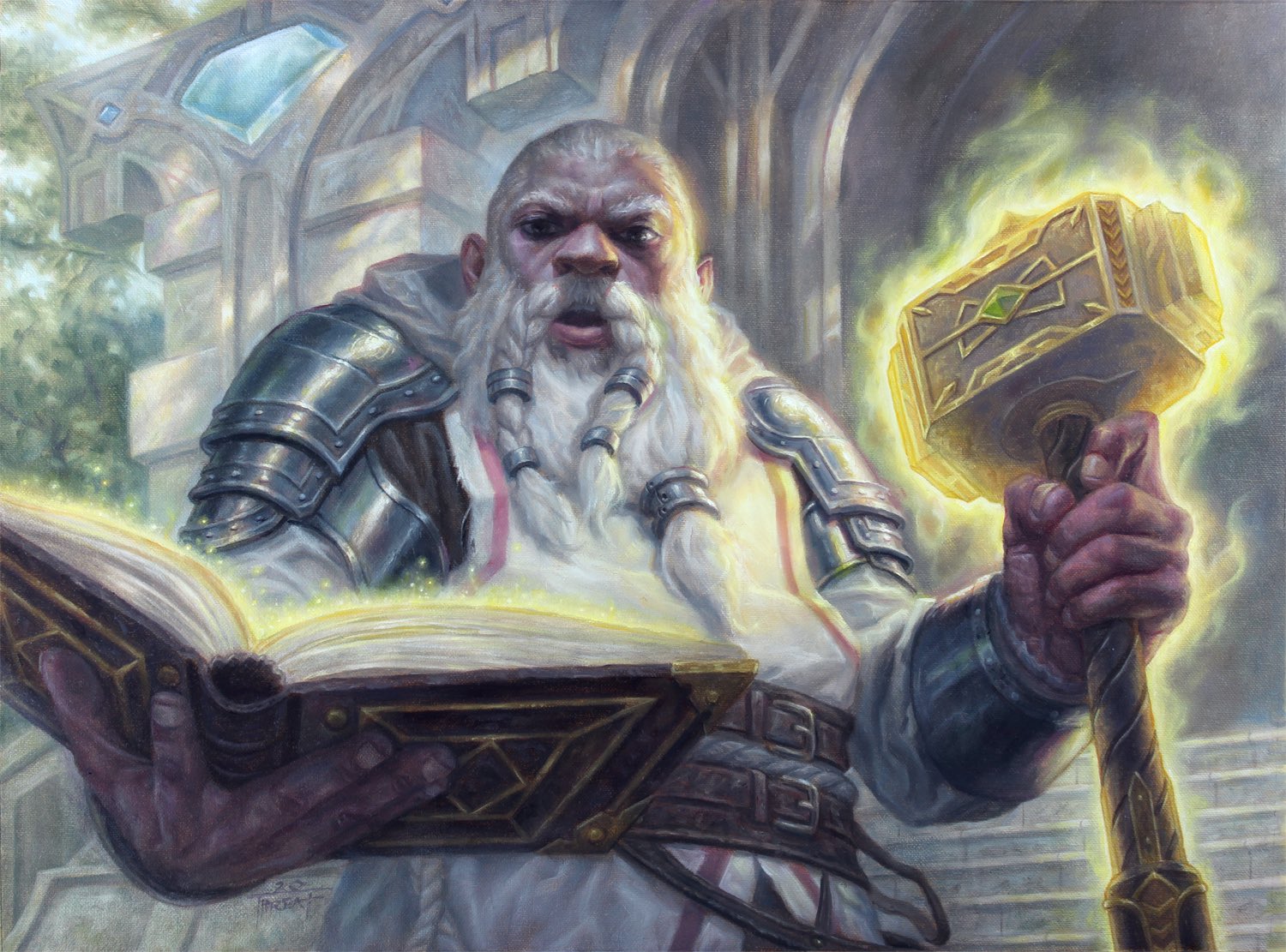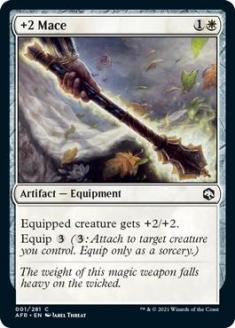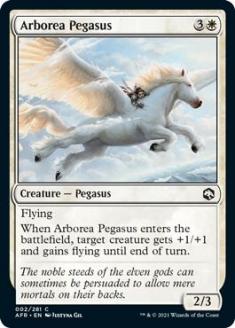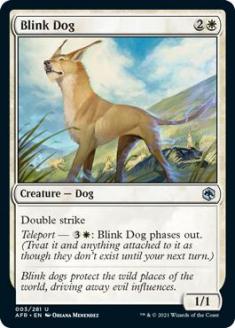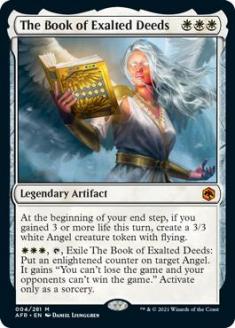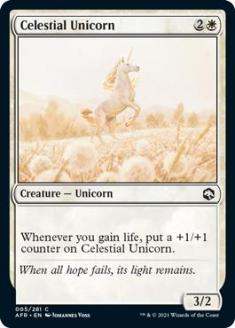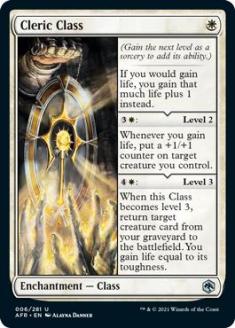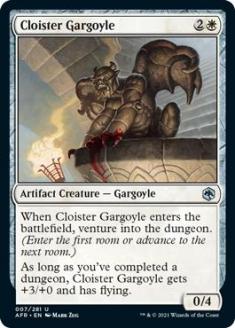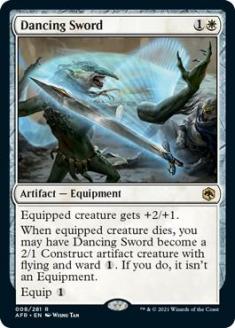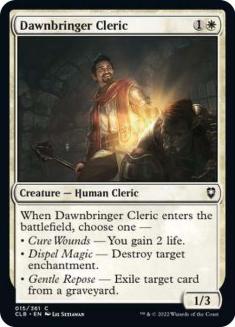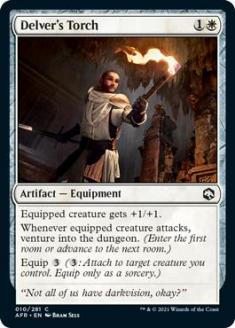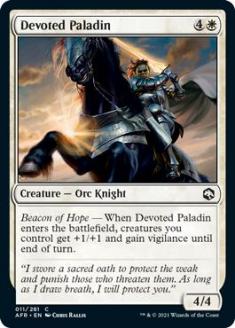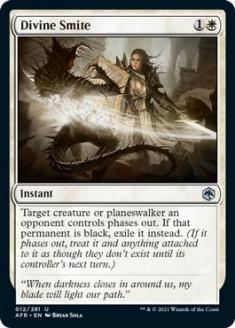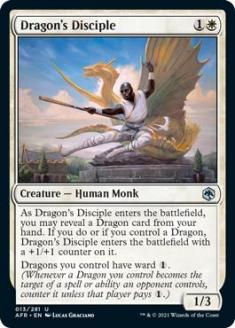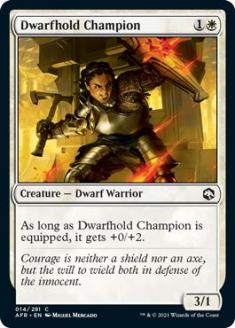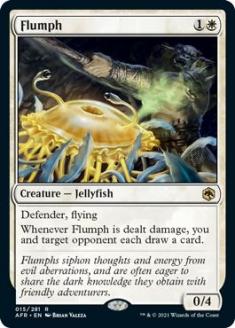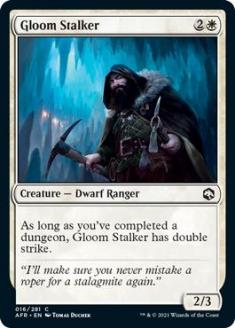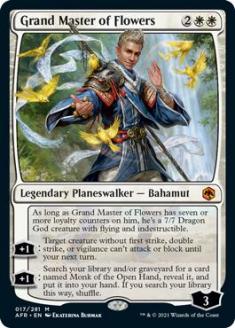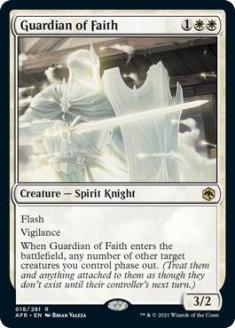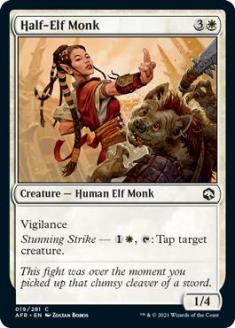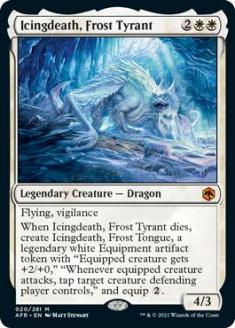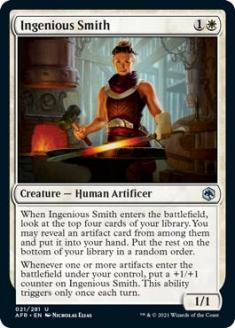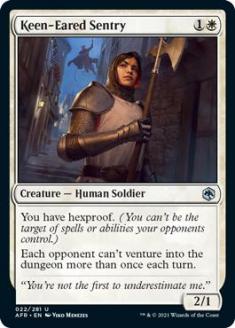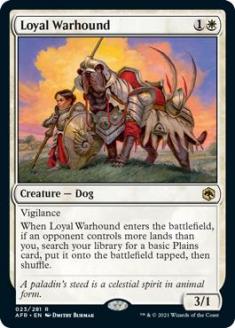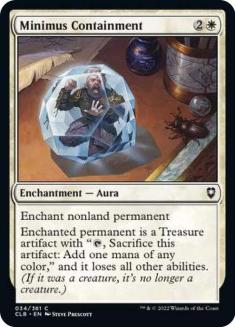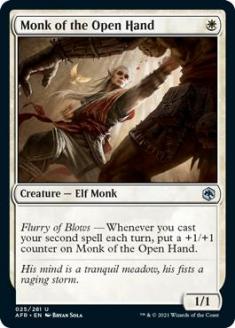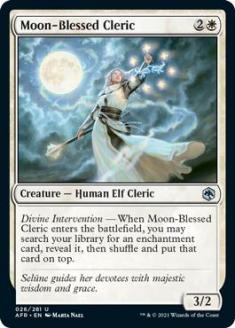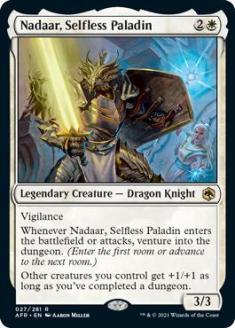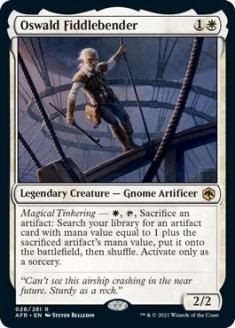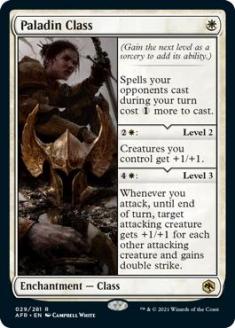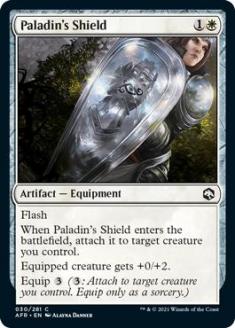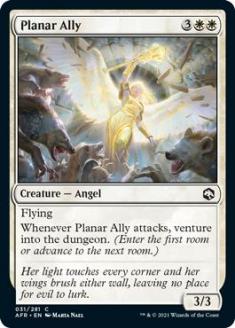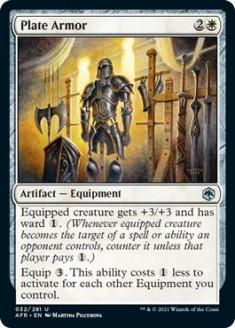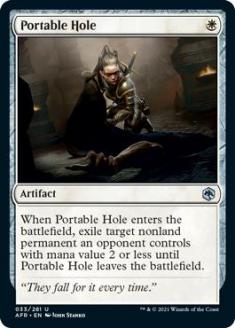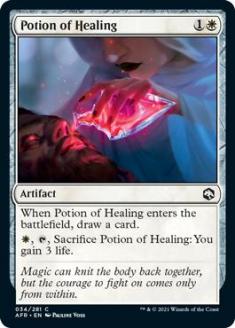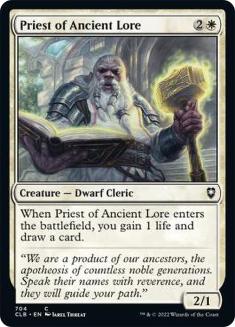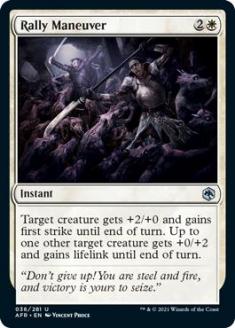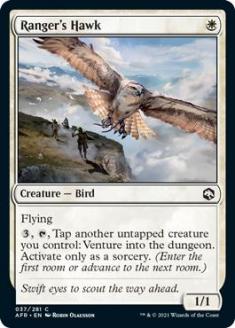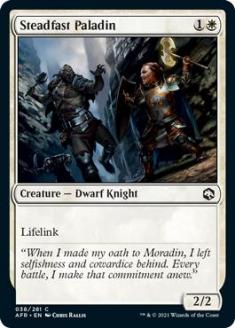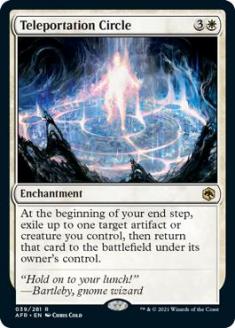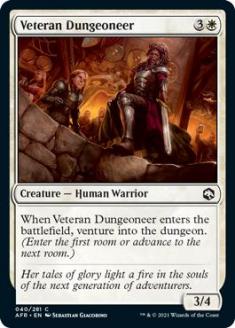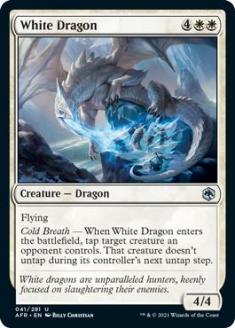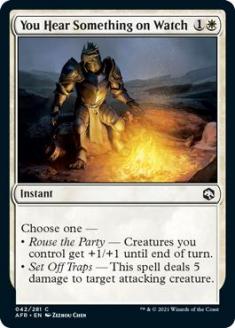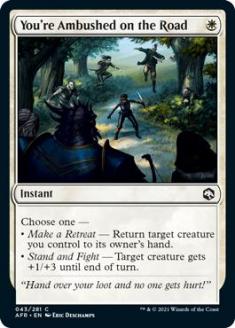Welcome to the D&D: Adventures in the Forgotten Realms set review series, written by someone who hasn’t participated in an actual D&D campaign since the 1990s. Fear not: I have played an absurd amount of Limited and managed to place three accounts in Mythic last month.
-2 Charisma for bragging.
I also feel like I would be remiss if I did not mention that this series may feel highly influenced by the Godfather of Limited Set Reviews, Luis Scott-Vargas. Simply put, he’s the best to ever do the dang thing and I couldn’t scrub the years and hundreds of thousands of words of draft content I’ve read by him from my brain if I tried. Credit where credit is due.
As such, we won’t be reinventing the grading rubric, which has your absolute bombs as 5.0 cards and unplayable, Constructed-only cards at 0.0. A 2.5 is a card you’re almost always playing, a card with two grades reflects that it’s great when it’s in the correct deck, and Sideboard indicates that a card is worthy of consideration in best-of-three matches.
Grades should never be considered in a vacuum. This is why we draft: making subjective calls with information about how a card will fit within a broader tapestry you have woven.
White Overview
Your core themes in white are as follows: gaining life, venturing, casting two spells a turn, and Equipment. Of these, I believe venture decks that repeatedly gain access to dungeon levels have the highest ceiling, Equipment decks play the most consistently, and the remaining archetypes have to be wide open with the correct enablers to play well.
Specific to lifegain, you’re looking at one common, two uncommon, and one mythic payoff you’re unlikely to see. Against aggressive decks, gaining any life is a boon while they try to outclock you, but adding the occasional +1/+1 counter against decks with a more cohesive long-term plan feels like you’re barely treading water.
+2 Mace
I’m not overly impressed with the Equipment payoffs in the set, but here the +2 Mace is likely worth the whopping equip cost of 3. When you’re amassing a literally small army of Goblin tokens, helping them make the leap from a terrible one-drop to an average three-drop is a substantial upgrade. With the correct creature count, a Mace is exactly what you want to be swinging with.
Grade: 2.0
Arborea Pegasus
With an above-average number of reach creatures, temporary flying isn’t what it used to be. Our winged friend seems like a fair mix of stats, but I assure you that the Arborea Pegasus isn’t holding its own in Adventures in the Forgotten Realms. Keep an eye on what you’re attacking with, as this plays much better in a Selesnya deck where a lot of your larger threats can get bogged down by a simple deathtouch creature.
Grade: 2.0
Blink Dog
The real question is: can you give this dog a sword? What about some sort of hammer? If the answer is, “Yes, reliably,” then I can’t see where this goes wrong. That is unless you don’t have 3W to Teleport it to safety. I like that there’s no awful time to draw this, as late in the game it can nullify an opponent’s largest ground threat like a good little guard dog. Still, this is not an auto-include and thus the split grade.
Grade: 1.0/2.5
The Book of Exalted Deeds
If there were more repeatable sources of lifegain, I would be much more impressed with The Book of Exalted Deeds. Notably, Adventures in the Forgotten Realms is incredibly light on lifelink, considering a core theme is, you know, gaining life. As it stands, this highly restrictive mana cost plus the hope that it will net you more than one 3/3 flyer means this is a bust for me outside of the most dedicated of lifegain decks. Even then, you’ll be left with scenarios where you’ll be stuck holding something that effects the battlefield and also gains you life while waiting on your third white source.
Grade: 1.0/3.0
Celestial Unicorn
A three-drop that grows with the game isn’t much of a Unicorn in the sense that it’s wildly rare anymore, but I’m happy to include one or two of these show ponies in any lifegain build as one of the few payoffs. A Turn 2 Steadfast Paladin means that, more often than not, you’re looking at a three-mana 4/3. This also plays well with Priest of Ancient Lore, an absolute must-include for white.
Grade: 2.5
Cleric Class
This is an exciting Class in that it will enable some big turns for you when you’ve laid a little groundwork. While I’m not betting big on gaining life dominating Draft formats, this will be a late pick you’ll always be happy to include for the Level 3 and the ability to reanimate for a bit of guaranteed pump. Without five-plus ways to gain life, I would consider this as borderline unplayable.
Grade: 1.5/3.0
Cloister Gargoyle
A fine defensive body that becomes a late-game threat when you’re doing the thing that white excells at in Adventures in the Forgotten Realms? This is a steal for three mana. Four toughness feels like the real deal when evaluating offensive threats here. To help accelerate the process, I implore you to avoid Dungeon of the Mad Mage if possible; it’ll be too hard to convert your Cloister Gargoyle to anything more than a Wall.
Grade: 3.5
Dancing Sword
Reasonable stats, cheap to equip, and the option to convert it to a threat as needed mean this isn’t relegated to the world of Boros Equipment. Keep in mind that the flyer-on-death mode is entirely optional, and often times you’ll be content to keep moving the Dancing Sword from creatures until your opponent has had enough. Finally, a dance challenge I feel confident embarking on.
Grade: 4.0
Dawnbringer Cleric
As much as I value the flexibility here, the body is too weak to make this feel like a card I consider playing outside of Selesnya. Graveyard hate isn’t something you’re clamoring for as there are a handful of cards here you’ll be itching to remove from an opponent’s bin. Readjust if Classes dominate the format early, but enchantment removal seems best in the battlefield, especially when playing single games on Arena.
Grade: 2.0
Delver’s Torch
I hate the equip cost, but I love repeatable ways to venture into the dungeon, so here we are. Ideally, you’re finding some form of equip reduction and getting this to a lean one mana or slapping it on a Planar Ally to get double duty later in the game. Note that this plays in any venture deck and Equipment deck, making it more versatile than a +2 Mace.
Grade: 2.5
Devoted Paladin
The design team gives us a bevy of go-wide payoffs here, but attaching a body makes this feel like the one I’m most likely to play at the top of my curve. Vigilance isn’t acutely relevant, as there are zero cards that penalize tapped creatures here and your only creature in white with an instant-speed tap effect already has it in Half-Elf Monk. Of course, this is designed with Boros in mind, so consider your creature count and attack triggers before tossing this in willy-nilly.
Grade: 2.5
Divine Smite
Stick to exiling, never phasing, as a single-creature Fog is not a card that you should be considering, even if there’s huge potential upside here.
Grade: Sideboard
Dragon’s Disciple
You shouldn’t be stacked with so many Dragons (five or more) that this is reliably a 2/4, and at that point I’m concerned about your curve. However, if you are, Dragon’s Disciple is pure capitalistic excess, which is pretty sweet when you’re on the receiving end. I consider ward 1 to be an incredibly mild bonus unless you’re cheating out Dragons at an incredible rate, as they should be able to find an answer that late in the game. You know, if they have one. Remember that both Jaded Sell-Sword and Wandering Troubadour count as cheaper options to reveal.
Grade: 1.0/2.5
Dwarfhold Champion
In aggressive decks, this is precisely what you’re looking for: an early threat that doesn’t trade for something awful when you can find a way to gear it up. I look forward to wheeling these early and often as a staple of Boros decks that other archetypes aren’t interested in. Consider playing Dueling Rapier, Leather Armor, and Paladin’s Shield when you reach a critical mass of Dwarfhold Champions (three or more) as these become massively more valuable whle still being available as later picks.
Grade: 2.5
Flumph
Symmetrical card draw effects never rate highly in Limited and seem like the opposite of what white wants to be doing in Adventures in the Forgotten Realms. If you’re looking to play a big game, you’re better off looking elsewhere, as white skews as a color looking to be on the offensive no matter which archetype you land in. Any block leaves your opponent in the position to play their card first, hit a land drop, and more.
Grade: 1.0
Gloom Stalker
While we want to be completing dungeons more than Jame Gumb in The Silence of the Lambs, this isn’t the payoff that gets me excited. 2/3 isn’t a set of stats I’m excited for on a double striker. Add needing to do work to get the keyword plus finding a way to buff it? Stalk someone else, bro.
Grade: 2.0
Grand Master of Flowers
I implore you to resist the temptation to find Monk of the Open Hand. The real win here is getting a 7/7 Dragon God and distracting your opponent while doing it, not fishing for 1/1s. Once the transformation is complete, there are almost no ways to interact with it The fact that this isn’t a guaranteed Pacifism doesn’t thrill me, but you’re happy to play the Grand Master of Bro-ing Out.
Grade: 3.5
Guardian of Faith
I prefer my flash creatures to be able to feast on an unwitting attacker, not holding on to them for an essential defensive play. With only two sweepers in the format, I’m not wild about the Faith or Guarding it. That leaves us with a 3/2 vigilance that occasionally helps save a life, like a teen working a summer job at the pool.
Grade: 3.0
Half-Elf Monk
Am I supposed to get excited for the vigilance here? So I can bash with my… 1/4? The body on this is like Tesla’s Cybertruck: all wrong. Where I think you’ll be successful is in your Selesnya decks that are looking to play a little longer game and need to tap down a problematic blocker, as that makes the 1W tap cost more palatable.
Grade: 2.0
Icingdeath, Frost Tyrant
Our first bomb Dragon, folks! Without a bevy of exile effects, I feel confident that you’ll be seeing quite a few Icingdeath, Frost Tongue tokens running around. A nice consolation prize for losing an over-statted creature that doesn’t take an arm and a leg’s worth of mana to get out there. It’s one thing to pay seven for your must-answer threat, but four is a truly sweet reward. I would avoid trading if possible, as artifact removal feels abundant.
Grade: 4.5
Ingenious Smith
The math on Ingenious Smith is not great. Even in the most dedicated Equipment decks, you’re going to whiff, leaving behind a 1/1. Even with some work, Agent Smith will only grow into a moderate threat when given time, so I don’t mind some non-dice gambling in decks with sufficient artifact counts. Otherwise, you’re better off playing any generic two-drop.
Grade: 1.5/3.0
Keen-Eared Sentry
This grade is a bet that consistently venturing into dungeons becomes the format-defining force I think it can be when that deck comes together. None of it is predicated on the giving of hexproof, for the record. The base stats aren’t awful, attacking for two instead of being created in the mold of a defensive white creature with an annoying passive ability.
Grade: 2.5
Loyal Warhound
Happy to jump on the saddle and ride this puppy to a bonus land. It slots nicely into any white deck and gives you a two-drop you don’t have to hold your nose to cast. This is precisely what I’m looking for when building out a curve.
Grade: 3.5
Minimus Containment
I don’t think Minimus Containment is as much of a slam dunk as usual, as providing a Treasure for your opponent makes me incredibly hesitant to play this early. Ideally, you’re using this to render a giant threat null instead of allowing your opponent to ramp into the said gnarly threat. With many game-warping artifacts and enchantments running around, throwing this on anything other than a land is excellent flexibility for the potential calamitous downside of giving them fixing or a payoff for a Treasures-matter card.
Grade: 3.0
Monk of the Open Hand
Reliably double-spelling on both your and your opponent’s turns would make this a ridiculous play. This feels playable in a Monk Class deck and very few places outside of that, as combat tricks tend to be more expensive than you’d think. In hyper-aggressive decks, I can see this continuing to follow in the foot steps of cards like Clever Lumimancer and being critical-hit-or-miss.
Grade: 2.0
Moon-Blessed Cleric
Tutoring for the Class you need is going to be a big game when you wind up with a solid one in your pool, while just medium when you need to fetch one of the quasi-removal Auras that Esper colors have access to. Combining this with Teleportation Circle seems like the stuff of Dante, while I suspect most drafters are happy to let you have at it. Avoid this in Boros, as you can only support so many themes.
Grade: 1.0/3.0
Nadaar, Selfless Paladin
If you manage to venture more than twice, Nadaar will feel positively busted, and you only need a single attack to get you in range. This is especially true when you can score a bonus like Storeroom or Fungi Cavern from Lost Mine of Phandelver to help keep attacking for more. Coming down late in the game with a banner effect in tow is great value for only three mana, so look for any and all ways to venture to completion. Protect Nadaar, Selfless Paladin at all costs.
Grade: 4.0
Oswald Fiddlebender
This is a bear with the most minor upside. You’ll rarely be able to trade your Equipment up for a much better option, as Birthing Pod typically involves ramping to something busted or with a strong enters-the-battlefield effect. Neither is a particular strong suit of Adventures in the Forgotten Realms‘s artifact suite. Cue someone curving a Potion of Healing into a Book of Something and running away with the game.
Grade: 2.0
Paladin Class
I want something better out of my initial passive effect here, but this will be a beating in Goblin decks. My big gripe is that decks only have room for so many of these effects, so you’re losing potential Equipment synergies. A permanent anthem for only 2W, however, is a gift horse I won’t be looking in the mouth. Level 3 providing a minimum of double strike each attack is the kind of inevitability that I want for my white decks later in the game.
Grade: 3.5
Paladin’s Shield
Only for those who are genuinely desperate for Equipment, this defensive boost doesn’t guarantee a combat victory while being cost-prohibitive when it comes to future use. This is exactly the type of trap I see players fall for when they wind up short on Equpment but want to profit off their synergies. Playing bad cards to enable medium effects is a net loss.
Grade: 1.0
Planar Ally
Evasive, repeatable venturing has to be good, right? The stats on Planar Ally aren’t bad, but you’ll need a way to stabilize the ground before feeling too overconfident about going to town. Orzhov decks in particular will love these at the top of the curve, but most white decks will find a home for at least one, making it a meaningful Ally (and not one that just Tweets).
Grade: 2.5
Plate Armor
What can I say? I love a man in uniform, and Plate Armor is all of the stat boosts you could want with a bit of ward tossed in for good measure. This has meaningful synergy with other Equipment, looking equippable on the turn it’s cast later in the game while being able to move it around when you need to be on both the offensive and defensive. This is going to generate considerable groans, and I’m here for it.
Grade: 3.5
Portable Hole
Cheap removal for cheap things seems valuable in a set where Classes and gold legends for two mana or less seem to be rampant. Venture decks, in particular, can be light on early interaction and need time to get deeper into their chosen dungeon. I’m also high on this card because I’ve been using it as a nickname that thoroughly confuses my future wife.
Grade: 3.0
Potion of Healing
Revitalize shouldn’t take this much work. Sadly, decks that demand ways to gain life don’t have a ton of options out there. Drawing the card initially does prevent this from feeling too awful, as you’re only losing the life at the point your opponent feels like they have to go after it. It’s like Four Loko, but if they only had One Loko.
Grade: 2.0
Priest of Ancient Lore
Blink it, equip it, put the thing down, flip it, and reverse it. Priest of Ancient Lore is my top white common, and I don’t think I can have enough of them, to be honest. Of course, getting a free body with the amount of Equipment you’ll be running is a boon, but this also plays well with an incidental blink/bounce spell, and is exactly the sort of card you want when it comes to lifegain decks.
Grade: 3.5
Rally Maneuver
Rally Maneuver will play better than I suspect it looks at first glance. While giving something first strike and lifelink could lead to some more interesting shenanigans, the blowout potential here will leave me suspicious of any opponent with 2W up until the end of the format. Other times, you’ll simply win a game the turn after your opponent thinks they have lethal, as instant-speed lifelink is a game-changer.
Grade: 3.0
Ranger’s Hawk
This feels like a Guided Voice-esque trap, where we look at a card for W and think it must be bad because we undervalue the mechanic associated with it. Tapping another creature plus three mana seems like a steep cost without the correct creatures to keep your opponent at bay. Even then, you create a scenario where a single removal spell leaves you wondering how much that venture was worth. I suspect I’ll throw this out the window and that during a battlefield stall, this Hawk will feel more like Hawkeye, but I don’t think this is a slam dunk for most white decks.
Grade: 2.0
Steadfast Paladin
You cannot be a lifegain deck in this format without a substantial Paladin presence and, ideally, a few Equipment around to toss on them. How else will you consistently add a +1/+1 counter to things with Cleric Class? White struggles with proactive two-drops, so keep an eye out for Steadfast Paladin if you value curve consistency,
Grade. 3.0
Teleportation Circle
I love a ton of enters-the-battlefield effects with Teleportation Circle, the most basic being a quick venture. Add to that the number of defensive Auras that you’ll face, and I like taking Teleportation Circle early and finding some friends to run under the parachute with like an elementary school gym class. Keep in mind that red has the fewest enters-the-battlefield effects, so this may play slightly worse in Boros decks.
Grade: 3.5
Veteran Dungeoneer
The Venture Sisters do exactly what you’re trying to do (venture) and absolutely nothing else. Dedicated Orzhov Venture decks already have both Clattering Skeletons and Barrowin of Clan Undurr in this slot, so no need to prioritize Veteran Dungeoneer too highly, although they’re the best defensive body. With blue in particular bouncing quite a bit, I prefer getting the trigger immediately instead of on death like with the Skels.
Grade: 2.5
White Dragon
Give me that sweet curve-topper with a classically blue enters-the-battlefield effect, design team! This feels like a 4.0 in most sets, but with everything gunning for your fly guys, you’ll have to settle for a momentary tap more than you typically would. In practice, White Dragon will lead to turns where you stay alive for another draw step or win the game by neutralizing their best defensive card. All of which I love on a 4/4 flyer with a sometimes-relevant creature type.
Grade: 3.5
You Hear Something on Watch
I enjoy the ability to cast You Hear Something on Watch offensively or defensively, but that usually means something has gone horribly wrong with your plan. The fact that this acts as removal means I’m higher on it than some of the other go-wide payoffs, but not by much. I suspect that five damage will be incredibly meaningful, as that kills all but nine creatures in the format for a mere 1W. The more trample you have, the better this card plays, as the actual block becomes irrelevant.
Grade: 3.0
You’re Ambushed on the Road
+1/+3 never feels like a solid set of stats on a combat trick, while having to recast one of your creatures is hard to generate a full card’s worth of value from. If you’re heavy on sweet enters-the-battlefield effects, you have worse options, and that’s one area where white seems well-positioned.
Grade: 1.5
Top Commons
- Priest of Ancient Lore
- Minimum Containment
- You Hear Something on Watch
- Planar Ally
- Dwarfhold Champion
White continues to see investment in its future from the design team, making it flexible enough to be aggressive, while synergistic when pursuing ventures. Unfortunately, I feel like half of the archetypes fail to come together in a meaningful way, leaving you stuck in midrange hell far too often.
Next up, we’ll look at blue, where tempo is back and it’s spectacular.

